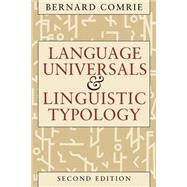
Note: Supplemental materials are not guaranteed with Rental or Used book purchases.
Purchase Benefits
Looking to rent a book? Rent Language Universals and Linguistic Typology: Syntax and Morphology [ISBN: 9780226114330] for the semester, quarter, and short term or search our site for other textbooks by Comrie, Bernard. Renting a textbook can save you up to 90% from the cost of buying.
| Preface to the second edition | |
| Preface to the first edition | |
| Preface to the second printing | |
| Language Universals | |
| Approaches to Language Universals | |
| Two major approaches | |
| The data base | |
| Degrees of abstractness | |
| Classification of Language Universals | |
| Formal and substantive universals | |
| Implicational and non-implicational universals | |
| Absolute universals and tendencies | |
| Explanations for Language Universals | |
| Common genetic origin | |
| External explanations | |
| Summary Notes and references | |
| Language Typology | |
| Typology and Universals | |
| Typological Parameters | |
| Morphological Typology | |
| Some Further Typological Parameters Notes and references | |
| Theoretical Prerequisites | |
| Semantic Roles | |
| Pragmatic Roles | |
| Grammatical Relations | |
| Morphological Cases | |
| Illustration: English and Russian Clause Structure Notes and references | |
| Word Order | |
| Word Order Parameters | |
| Correlations Among Word Order Parameters | |
| Greenberg's correlations | |
| Generalizations of Greenberg's results | |
| Critique of the generalizations | |
| The Value of Word Order Typology Notes and references | |
| Subject | |
| The Problem | |
| On Definitions and Categories | |
| Ergativity | |
| Semantic and Pragmatic Factors Notes and references | |
| Case Marking | |
| The Discriminatory Function of Cases | |
| Natural Information Flow in the Transitive Construction | |
| Inverse forms | |
| Differential marking of A and P | |
| Summary Notes and References | |
| Relative Clauses | |
| Some Typological Characteristics of English Relative Clauses | |
| Types of Relative Clause | |
| Defining the notion relative clause | |
| Word order and relative clause types | |
| The role of the head in the relative clause | |
| The role of the head in the main clause | |
| Accessibility to Relative Clause Formation | |
| Simplex sentences | |
| Complex constructions | |
| The distribution of relative clause types Notes and references | |
| Causative Constructions | |
| Parameters in the Study of Causative Constructions | |
| Formal parameters | |
| Semantic parameters | |
| Valency Changes in Morphological Causatives Notes and references | |
| Animacy | |
| Introduction: The Nature of Animacy | |
| Phenomena Controlled by Animacy | |
| Conceptual Animacy Distinctions | |
| Conclusions: The Nature of Animacy Notes and references | |
| Typological and Historical Linguistics | |
| Diachronic Dimensions in Universals and Typology | |
| Areal Typology | |
| Typology and Reconstruction | |
| Word order typology | |
| Word order and morpheme order | |
| Typology and Diachronic Explanation Notes and references | |
| Conclusions and Prospects Map showing location of languages cited References | |
| Index of languages | |
| Index of proper names | |
| Index of topics | |
| Table of Contents provided by Publisher. All Rights Reserved. |
The New copy of this book will include any supplemental materials advertised. Please check the title of the book to determine if it should include any access cards, study guides, lab manuals, CDs, etc.
The Used, Rental and eBook copies of this book are not guaranteed to include any supplemental materials. Typically, only the book itself is included. This is true even if the title states it includes any access cards, study guides, lab manuals, CDs, etc.